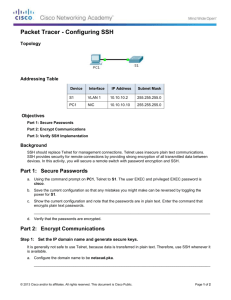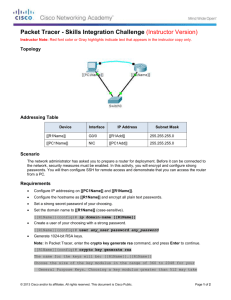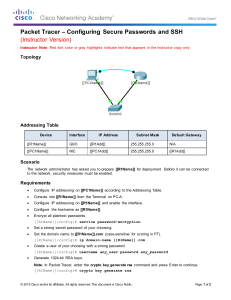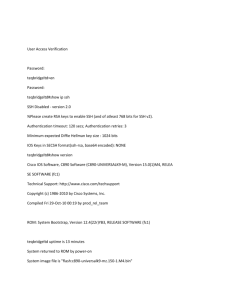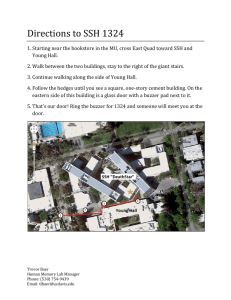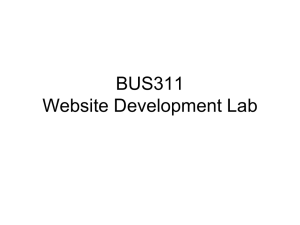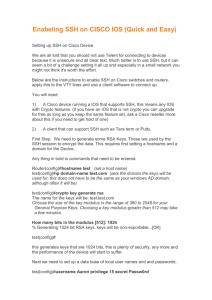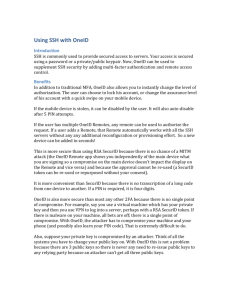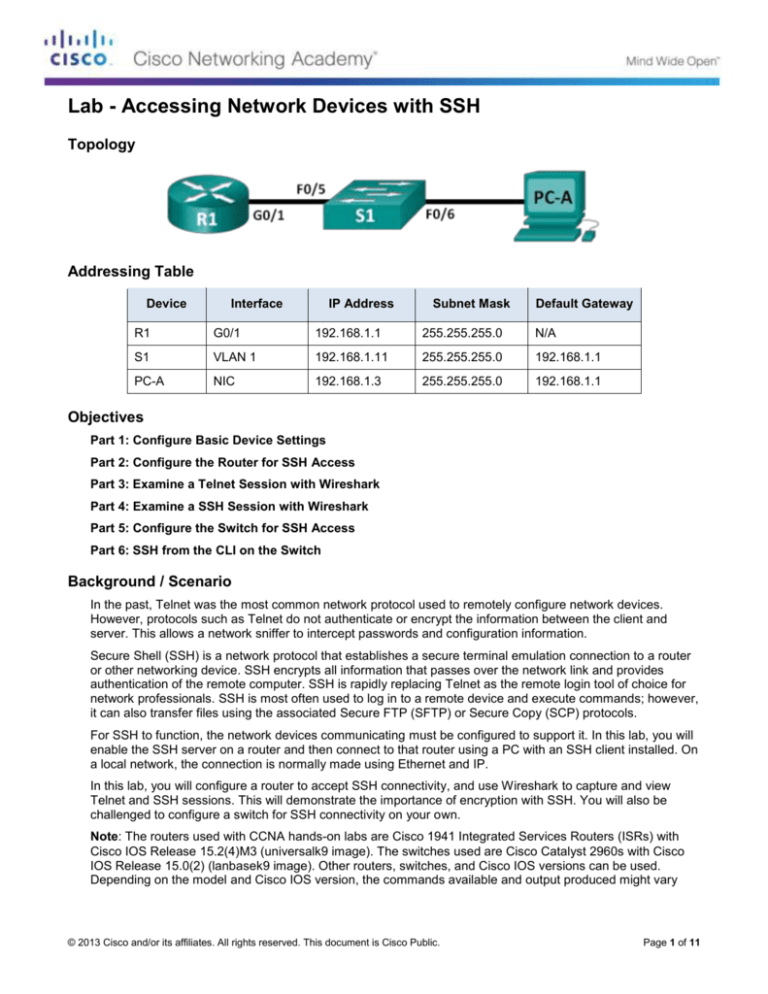
Lab - Accessing Network Devices with SSH
Topology
Addressing Table
Device
Interface
IP Address
Subnet Mask
Default Gateway
R1
G0/1
192.168.1.1
255.255.255.0
N/A
S1
VLAN 1
192.168.1.11
255.255.255.0
192.168.1.1
PC-A
NIC
192.168.1.3
255.255.255.0
192.168.1.1
Objectives
Part 1: Configure Basic Device Settings
Part 2: Configure the Router for SSH Access
Part 3: Examine a Telnet Session with Wireshark
Part 4: Examine a SSH Session with Wireshark
Part 5: Configure the Switch for SSH Access
Part 6: SSH from the CLI on the Switch
Background / Scenario
In the past, Telnet was the most common network protocol used to remotely configure network devices.
However, protocols such as Telnet do not authenticate or encrypt the information between the client and
server. This allows a network sniffer to intercept passwords and configuration information.
Secure Shell (SSH) is a network protocol that establishes a secure terminal emulation connection to a router
or other networking device. SSH encrypts all information that passes over the network link and provides
authentication of the remote computer. SSH is rapidly replacing Telnet as the remote login tool of choice for
network professionals. SSH is most often used to log in to a remote device and execute commands; however,
it can also transfer files using the associated Secure FTP (SFTP) or Secure Copy (SCP) protocols.
For SSH to function, the network devices communicating must be configured to support it. In this lab, you will
enable the SSH server on a router and then connect to that router using a PC with an SSH client installed. On
a local network, the connection is normally made using Ethernet and IP.
In this lab, you will configure a router to accept SSH connectivity, and use Wireshark to capture and view
Telnet and SSH sessions. This will demonstrate the importance of encryption with SSH. You will also be
challenged to configure a switch for SSH connectivity on your own.
Note: The routers used with CCNA hands-on labs are Cisco 1941 Integrated Services Routers (ISRs) with
Cisco IOS Release 15.2(4)M3 (universalk9 image). The switches used are Cisco Catalyst 2960s with Cisco
IOS Release 15.0(2) (lanbasek9 image). Other routers, switches, and Cisco IOS versions can be used.
Depending on the model and Cisco IOS version, the commands available and output produced might vary
© 2013 Cisco and/or its affiliates. All rights reserved. This document is Cisco Public.
Page 1 of 11
Lab - Accessing Network Devices with SSH
from what is shown in the labs. Refer to the Router Interface Summary Table at the end of this lab for the
correct interface identifiers.
Note: Make sure that the routers and switches have been erased and have no startup configurations. If you
are unsure, contact your instructor.
Required Resources
1 Router (Cisco 1941 with Cisco IOS Release 15.2(4)M3 universal image or comparable)
1 Switch (Cisco 2960 with Cisco IOS Release 15.0(2) lanbasek9 image or comparable)
1 PC (Windows 7, Vista, or XP with terminal emulation program, such as Tera Term, and Wireshark
installed)
Console cables to configure the Cisco IOS devices via the console ports
Ethernet cables as shown in the topology
Part 1: Configure Basic Device Settings
In Part 1, you will set up the network topology and configure basic settings, such as the interface IP
addresses, device access, and passwords on the router.
Step 1: Cable the network as shown in the topology.
Step 2: Initialize and reload the router and switch.
Step 3: Configure the router.
a. Console into the router and enable privileged EXEC mode.
b. Enter configuration mode.
c.
Disable DNS lookup to prevent the router from attempting to translate incorrectly entered commands as
though they were host names.
d. Assign class as the privileged EXEC encrypted password.
e. Assign cisco as the console password and enable login.
f.
Assign cisco as the vty password and enable login.
g. Encrypt the plain text passwords.
h. Create a banner that will warn anyone accessing the device that unauthorized access is prohibited.
i.
Configure and activate the G0/1 interface on the router using the information contained in the Addressing
Table.
j.
Save the running configuration to the startup configuration file.
Step 4: Configure PC-A.
a. Configure PC-A with an IP address and subnet mask.
b. Configure a default gateway for PC-A.
Step 5: Verify network connectivity.
Ping R1 from PC-A. If the ping fails, troubleshoot the connection.
© 2013 Cisco and/or its affiliates. All rights reserved. This document is Cisco Public.
Page 2 of 11
Lab - Accessing Network Devices with SSH
Part 2: Configure the Router for SSH Access
Using Telnet to connect to a network device is a security risk, because all information is transmitted in a clear
text format. SSH encrypts the session data and provides device authentication, which is why SSH is
recommended for remote connections. In Part 2, you will configure the router to accept SSH connections over
the VTY lines.
Step 1: Configure device authentication.
The device name and domain are used as part in the crypto key when it is generated. Therefore, these
names must be entered prior to issuing the crypto key command.
a. Configure device name.
Router(config)# hostname R1
b. Configure the domain for the device.
R1(config)# ip domain-name ccna-lab.com
Step 2: Configure the encryption key method.
R1(config)# crypto key generate rsa modulus 1024
The name for the keys will be: R1.ccna-lab.com
% The key modulus size is 1024 bits
% Generating 1024 bit RSA keys, keys will be non-exportable...
[OK] (elapsed time was 1 seconds)
R1(config)#
*Jan 28 21:09:29.867: %SSH-5-ENABLED: SSH 1.99 has been enabled
Step 3: Configure a local database username.
R1(config)# username admin privilege 15 secret adminpass
R1(config)#
*Feb 6 23:24:43.971: End->Password:QHjxdsVkjtoP7VxKIcPsLdTiMIvyLkyjT1HbmYxZigc
R1(config)#
Note: A privilege level of 15 gives the user administrator rights.
Step 4: Enable SSH on the VTY lines.
a. Enable Telnet and SSH on the inbound VTY lines using the transport input command.
R1(config)# line vty 0 4
R1(config-line)# transport input telnet ssh
b. Change the login method to use the local database for user verification.
R1(config-line)# login local
R1(config-line)# end
R1#
Step 5: Save the running configuration to the startup configuration file.
R1# copy running-config startup-config
Destination filename [startup-config]?
© 2013 Cisco and/or its affiliates. All rights reserved. This document is Cisco Public.
Page 3 of 11
Lab - Accessing Network Devices with SSH
Building configuration...
[OK]
R1#
Part 3: Examine a Telnet Session with Wireshark
In Part 3, you will use Wireshark to capture and view the transmitted data of a Telnet session on the router.
You will use Tera Term to telnet to R1, sign in, and then issue the show run command on the router.
Note: If a Telnet/SSH client software package is not installed on your PC, you must install one before
continuing. Two popular freeware Telnet/SSH packages are Tera Term (http://download.cnet.com/TeraTerm/3000-20432_4-75766675.html) and PuTTy (www.putty.org).
Note: Telnet is not available from the command prompt in Windows 7, by default. To enable Telnet for use in
the command prompt window, click Start > Control Panel > Programs > Programs and Features > Turn
Windows features on or off. Click the Telnet Client check box, and then click OK.
Step 1: Open Wireshark and start capturing data on the LAN interface.
Note: If you are unable to start the capture on the LAN interface, you may need to open Wireshark using the
Run as Administrator option.
Step 2: Start a Telnet session to the router.
a. Open Tera Term and select the Telnet Service radio button and in the Host field, enter 192.168.1.1.
What is the default TCP port for Telnet sessions? _________________
b. At the Username: prompt, enter admin and at the Password: prompt, enter adminpass. These prompts
are generated because you configured the VTY lines to use the local database with the login local
command.
© 2013 Cisco and/or its affiliates. All rights reserved. This document is Cisco Public.
Page 4 of 11
Lab - Accessing Network Devices with SSH
c.
Issue the show run command.
R1# show run
d. Enter exit to exit the Telnet session and out of Tera Term.
R1# exit
Step 3: Stop the Wireshark capture.
Step 4: Apply a Telnet filter on the Wireshark capture data.
Step 5: Use the Follow TCP Stream feature in Wireshark to view the Telnet session.
a. Right-click one of the Telnet lines in the Packet list section of Wireshark, and in the drop-down list, select
Follow TCP Stream.
© 2013 Cisco and/or its affiliates. All rights reserved. This document is Cisco Public.
Page 5 of 11
Lab - Accessing Network Devices with SSH
b. The Follow TCP Stream window displays the data for your Telnet session with the router. The entire
session is displayed in clear text, including your password. Notice that the username and show run
command that you entered are displayed with duplicate characters. This is caused by the echo setting in
Telnet to allow you to view the characters that you type on the screen.
c.
After you have finished reviewing your Telnet session in the Follow TCP Stream window, click Close.
Part 4: Examine an SSH session with Wireshark
In Part 4, you will use the Tera Term software to establish an SSH session with the router. Wireshark will be
used to capture and view the data of this SSH session.
Step 1: Open Wireshark and start capturing data on the LAN interface.
Step 2: Start an SSH session on the router.
a. Open Tera Term and enter the G0/1 interface IP address of R1 in the Host: field of the Tera Term: New
Connection window. Ensure that the SSH radio button is selected and then click OK to connect to the
router.
© 2013 Cisco and/or its affiliates. All rights reserved. This document is Cisco Public.
Page 6 of 11
Lab - Accessing Network Devices with SSH
What is the default TCP port used for SSH sessions? __________________
b. The first time you establish a SSH session to a device, a SECURITY WARNING is generated to let you
know that you have not connected to this device before. This message is part of the authentication
process. Read the security warning and then click Continue.
c.
In the SSH Authentication window, enter admin for the username and adminpass for the passphrase.
Click OK to sign into the router.
© 2013 Cisco and/or its affiliates. All rights reserved. This document is Cisco Public.
Page 7 of 11
Lab - Accessing Network Devices with SSH
d. You have established a SSH session on the router. The Tera Term software looks very similar to a
command window. At the command prompt, issue the show run command.
e. Exit the SSH session and out of Tera Term by issuing the exit command.
R1# exit
Step 3: Stop the Wireshark capture.
Step 4: Apply an SSH filter on the Wireshark Capture data.
© 2013 Cisco and/or its affiliates. All rights reserved. This document is Cisco Public.
Page 8 of 11
Lab - Accessing Network Devices with SSH
Step 5: Use the Follow TCP Stream feature in Wireshark to view the Telnet session.
a. Right-click one of the SSHv2 lines in the Packet list section of Wireshark, and in the drop-down list,
select the Follow TCP Stream option.
b. Examine the Follow TCP Stream window of your SSH session. The data has been encrypted and is
unreadable. Compare the data in your SSH session to the data of your Telnet session.
Why is SSH preferred over Telnet for remote connections?
____________________________________________________________________________________
____________________________________________________________________________________
c.
After examining your SSH session, click Close.
d. Close Wireshark.
Part 5: Configure the Switch for SSH Access
In Part 5, you are to configure the switch in the topology to accept SSH connections. Once the switch has
been configured, establish a SSH session on it using Tera Term.
© 2013 Cisco and/or its affiliates. All rights reserved. This document is Cisco Public.
Page 9 of 11
Lab - Accessing Network Devices with SSH
Step 1: Configure the basic settings on the switch.
Step 2: Configure the switch for SSH connectivity.
Use the same commands that you used to configure SSH on the router in Part 2 to configure SSH for the
switch.
Step 3: Establish a SSH connection to the switch.
Start Tera Term from PC-A, and then SSH to the SVI interface on the S1.
Step 4: Troubleshoot as necessary.
Are you able to establish a SSH session with the switch?
_______________________________________________________________________________________
Part 6: SSH From the CLI on the Switch
The SSH client is built into the Cisco IOS and can be run from the CLI. In Part 6, you will SSH to the router
from the CLI on the switch.
Step 1: View the parameters available for the Cisco IOS SSH client.
Use the question mark (?) to display the parameter options available with the ssh command.
S1# ssh
-c
-l
-m
-o
-p
-v
-vrf
WORD
?
Select encryption algorithm
Log in using this user name
Select HMAC algorithm
Specify options
Connect to this port
Specify SSH Protocol Version
Specify vrf name
IP address or hostname of a remote system
Step 2: SSH to router R1 from S1.
a. You must use the –l admin option when you SSH to R1. This allows you to log in as user admin. When
prompted, enter adminpass for the password.
S1# ssh -l admin 192.168.1.1
Password:
***********************************************
Warning: Unauthorized Access is Prohibited!
***********************************************
R1#
b. You can return to S1 without closing your SSH session to R1 by pressing Ctrl+Shift+6. Release the
Ctrl+Shift+6 keys and press x. You should see the switch privilege EXEC prompt display.
R1#
S1#
© 2013 Cisco and/or its affiliates. All rights reserved. This document is Cisco Public.
Page 10 of 11
Lab - Accessing Network Devices with SSH
c.
To return to the SSH session on R1, press Enter on a blank CLI line. You may need to press Enter a
second time to see the router CLI prompt.
S1#
[Resuming connection 1 to 192.168.1.1 ... ]
R1#
d. To end the SSH session on R1, type exit at the router prompt.
R1# exit
[Connection to 192.168.1.1 closed by foreign host]
S1#
What versions of SSH are supported from the CLI?
_______________________________________________________________________________________
_______________________________________________________________________________________
Reflection
How would you provide multiple users, each with their own username, access to a network device?
_______________________________________________________________________________________
_______________________________________________________________________________________
Router Interface Summary Table
Router Interface Summary
Router Model
Ethernet Interface #1
Ethernet Interface #2
Serial Interface #1
Serial Interface #2
1800
Fast Ethernet 0/0
(F0/0)
Fast Ethernet 0/1
(F0/1)
Serial 0/0/0 (S0/0/0)
Serial 0/0/1 (S0/0/1)
1900
Gigabit Ethernet 0/0
(G0/0)
Gigabit Ethernet 0/1
(G0/1)
Serial 0/0/0 (S0/0/0)
Serial 0/0/1 (S0/0/1)
2801
Fast Ethernet 0/0
(F0/0)
Fast Ethernet 0/1
(F0/1)
Serial 0/1/0 (S0/1/0)
Serial 0/1/1 (S0/1/1)
2811
Fast Ethernet 0/0
(F0/0)
Fast Ethernet 0/1
(F0/1)
Serial 0/0/0 (S0/0/0)
Serial 0/0/1 (S0/0/1)
2900
Gigabit Ethernet 0/0
(G0/0)
Gigabit Ethernet 0/1
(G0/1)
Serial 0/0/0 (S0/0/0)
Serial 0/0/1 (S0/0/1)
Note: To find out how the router is configured, look at the interfaces to identify the type of router and how many
interfaces the router has. There is no way to effectively list all the combinations of configurations for each router
class. This table includes identifiers for the possible combinations of Ethernet and Serial interfaces in the device.
The table does not include any other type of interface, even though a specific router may contain one. An
example of this might be an ISDN BRI interface. The string in parenthesis is the legal abbreviation that can be
used in Cisco IOS commands to represent the interface.
© 2013 Cisco and/or its affiliates. All rights reserved. This document is Cisco Public.
Page 11 of 11

